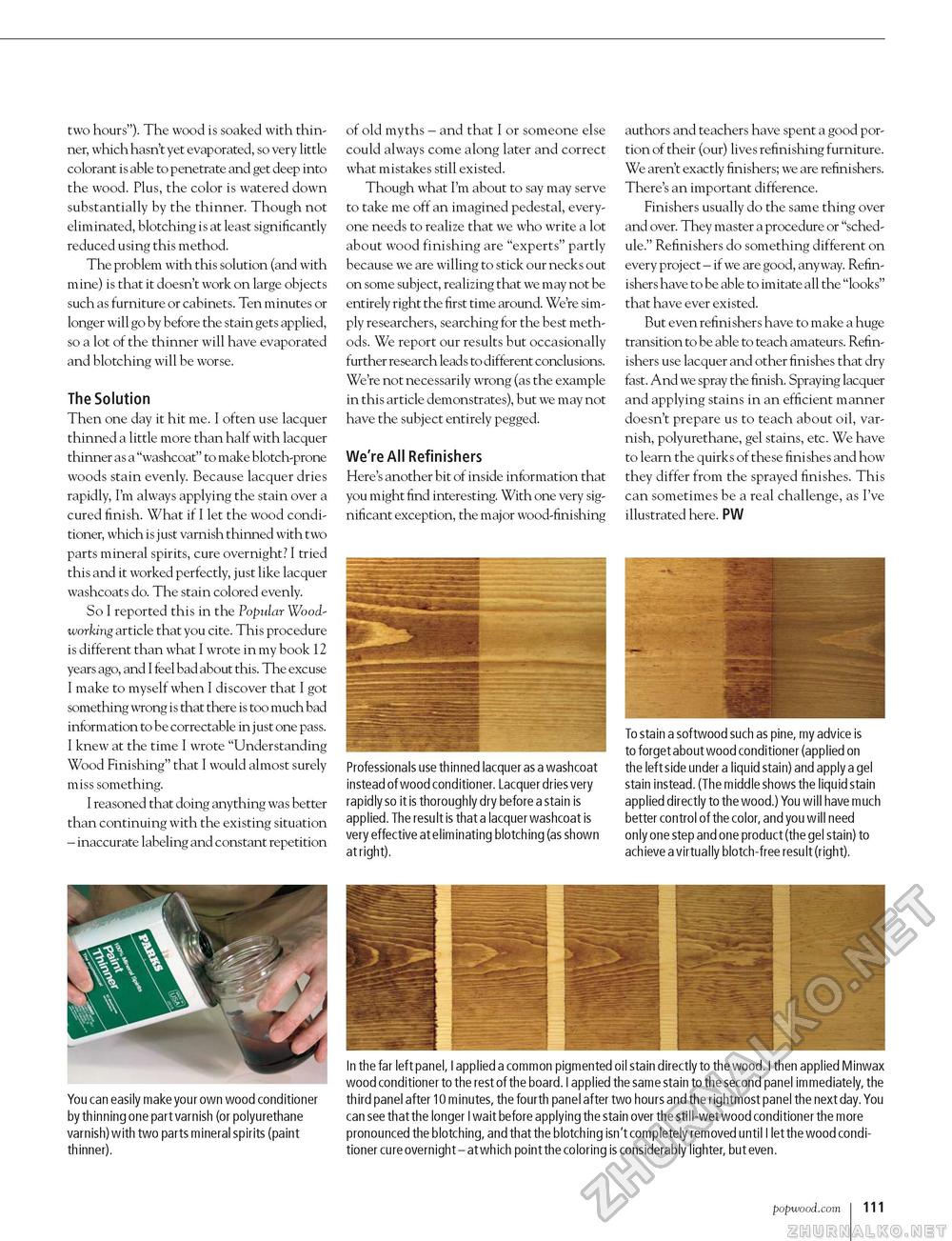Popular Woodworking 2005-10 № 150, страница 115
two hours"). The wood is soaked with thinner, which hasn't yet evaporated, so very little colorant is able to penetrate and get deep into the wood. Plus, the color is watered down substantially by the thinner. Though not eliminated, blotching is at least significantly reduced using this method. The problem with this solution (and with mine) is that it doesn't work on large objects such as furniture or cabinets. Ten minutes or longer will go by before the stain gets applied, so a lot of the thinner will have evaporated and blotching will be worse. The Solution Then one day it hit me. I often use lacquer thinned a little more than half with lacquer thinner as a "washcoat" to make blotch-prone woods stain evenly. Because lacquer dries rapidly, I'm always applying the stain over a cured finish. What if I let the wood conditioner, which is just varnish thinned with two parts mineral spirits, cure overnight? I tried this and it worked perfectly, just like lacquer washcoats do. The stain colored evenly. So I reported this in the Popular Woodworking article that you cite. This procedure is different than what I wrote in my book 12 years ago, and I feel bad about this. The excuse I make to myself when I discover that I got something wrong is that there is too much bad information to be correctable in just one pass. I knew at the time I wrote "Understanding Wood Finishing" that I would almost surely miss something. I reasoned that doing anything was better than continuing with the existing situation - inaccurate labeling and constant repetition You can easily make your own wood conditioner by thinning one part varnish (or polyurethane varnish) with two parts mineral spirits (paint thinner). of old myths - and that I or someone else could always come along later and correct what mistakes still existed. Though what I'm about to say may serve to take me off an imagined pedestal, everyone needs to realize that we who write a lot about wood finishing are "experts" partly because we are willing to stick our necks out on some subject, realizing that we may not be entirely right the first time around. We're simply researchers, searching for the best methods. We report our results but occasionally further research leads to different conclusions. We're not necessarily wrong (as the example in this article demonstrates), but we may not have the subject entirely pegged. We're All Refinishers Here's another bit of inside information that you might find interesting. With one very significant exception, the major wood-finishing Professionals use thinned lacquer as a washcoat instead of wood conditioner. Lacquer dries very rapidly so it is thoroughly dry before a stain is applied. The result is that a lacquer washcoat is very effective at eliminating blotching (as shown at right). authors and teachers have spent a good portion of their (our) lives refinishing furniture. We aren't exactly finishers; we are refinishers. There's an important difference. Finishers usually do the same thing over and over. They master a procedure or "schedule." Refinishers do something different on every project - if we are good, anyway. Refinishers have to be able to imitate all the "looks" that have ever existed. But even refinishers have to make a huge transition to be able to teach amateurs. Refinishers use lacquer and other finishes that dry fast. And we spray the finish. Spraying lacquer and applying stains in an efficient manner doesn't prepare us to teach about oil, varnish, polyurethane, gel stains, etc. We have to learn the quirks of these finishes and how they differ from the sprayed finishes. This can sometimes be a real challenge, as I've illustrated here. PW To stain a softwood such as pine, my advice is to forget about wood conditioner (applied on the left side under a liquid stain) and apply a gel stain instead. (The middle shows the liquid stain applied directly to the wood.) You will have much better control of the color, and you will need only one step and one product (the gel stain) to achieve a virtually blotch-free result (right). third panel after 10 minutes, the fourth panel after two hours and the rightmost panel the next day. You can see that the longer I wait before applying the stain over the still-wet wood conditioner the more pronounced the blotching, and that the blotching isn't completely removed until I let the wood conditioner cure overnight - at which point the coloring is considerably lighter, but even. popwood.com i 111 |








